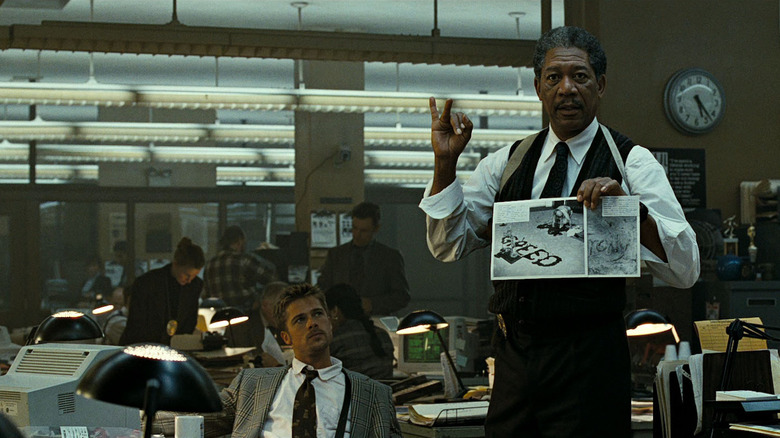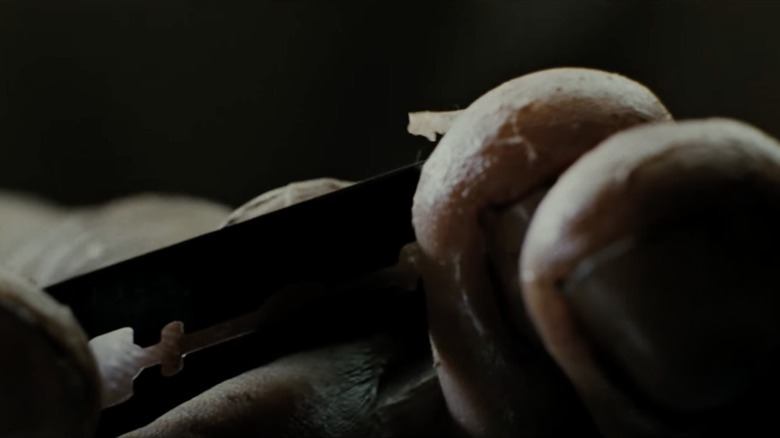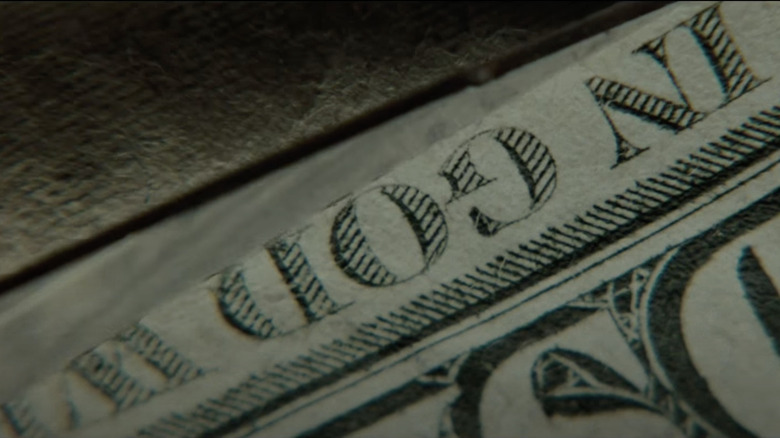Seven's Groundbreaking Credits Sequence All Started As A Joke
"Seven" wastes no time, introducing Detectives Somerset (Morgan Freeman) and Mills (Brad Pitt) to each other and the audience within five minutes. If the gruesome murder scene they investigate together isn't enough to establish a grim mood, then the opening titles are.
While it takes until the third act for the killer "John Doe" to appear, the title sequence gives viewers an early peak into his twisted mind. Kyle Cooper, the designer of the title sequence, has said, "I was really into horror movies when I was a kid, and I used to get frustrated when they'd hold back the monster to the very end."
A series of extreme close-ups, sometimes overlaid on top of each other, show gruesome pictures, the killer journaling and developing photographs, and destroying his own fingertips with a razor blade. Interspersed are credits, which were scratched onto a blackboard to ensure the typography was unclean. The sequence's score is a remix of Nine Inch Nails' sadomasochistic anthem "Closer."
Director David Fincher began as a music video director and the sequence reflects that experience, especially with how the footage is cut to mirror the beats of the music. The scene burns its disturbing imagery into your brain, but according to late cinematographer Harris Savides (who shot the sequence), the horror all began with some lighthearted fooling around.
Designing the titles
Savides worked with Fincher again on "Zodiac," where he once again served as director of photography. In that film's production notes, he described shooting the "Seven" title sequence and revealed the two-day process started as, "goofin' around." Savides remembered:
"There was a sequence where we started doing these close-ups of a string tied around a guy's finger really tight, trying to make it scary and intense. I started laughing so hard the camera started shaking and we just went with it! And that's how we came up with that jagged image moving effect! It is kind of funny that it took off."
Indeed, according to Cooper, Fincher initially envisioned the title sequence as nothing close to what Savides shot. Interviewed by Empire, Cooper revealed the director wanted the opening to show Somerset taking a train ride out to the suburbs and looking at a quaint house he wanted to retire in. The film would open with a glimmer of hope before the rest of the film tears it away.
But the film needed a placeholder title sequence for the studio test screening. So Cooper cut together a slideshow, with stills of Doe's notebooks set to "Closer" (supplied by Fincher himself). Both the New Line Cinema executives and Cooper liked the slideshow so much that they suggested using the placeholder as the basis for the final title sequence. After being persuaded by Cooper, Fincher relented. He initially wanted Mark Romanek, director of the "Closer" music video, to create the final version, but Cooper wanted to direct it himself and was again able to convince Fincher.
Assembling the titles
The sequence was modeled on storyboards supplied by artist Wayne Coe, such as the shot of John Doe cutting out "God" from a dollar bill, the sequence's biggest hint of his motives. Cooper said (via Empire): "[Doe's killings are all about the Seven Deadly Sins and he's making himself out to be God.]"
Once the shoot was complete, Cooper and his team physically edited the sequence instead of doing it digitally. Mixed with the personalized handwriting in the notebooks, the extreme close-ups of Doe's finger, and scratched-in titles, the sequence was frighteningly tactile.
This set the tone of "Seven" magnificently, so much so that later serial killer films would ape it. "Red Dragon" owes more to the visual language of "Seven" than it does its own originator, "The Silence of the Lambs." The opening credits are a montage of newspapers documenting Hannibal Lecter's (Anthony Hopkins) arrest by Will Graham (Edward Norton) and killer Francis Dolarhyde's (Ralph Fiennes) journals. The journals, including both Dolarhyde's handwriting and drawings such as Da Vinci's Vitruvian Man and a Chinese Dragon, show the obvious influence of "Seven."
However, the sequence misses what made the "Seven" opening so creepy. In "Red Dragon," the shots last longer and there are no overlaid images (meaning less disorientation). The credits are simple digital text. The music (the film's orchestral titles composed by Danny Elfman) isn't as skin-crawling as "Closer." The camera movement is much smoother, with none of the shakiness caused by Savides' laughter.
The "Seven" titles are a testament to making it up as you go. As Cooper put it, "You can plan for everything and say we're going to do something that looks effortless, but that's not really realistic — it takes on a life of its own." Sometimes, "goofin' around" can create accidental ingenuity.


